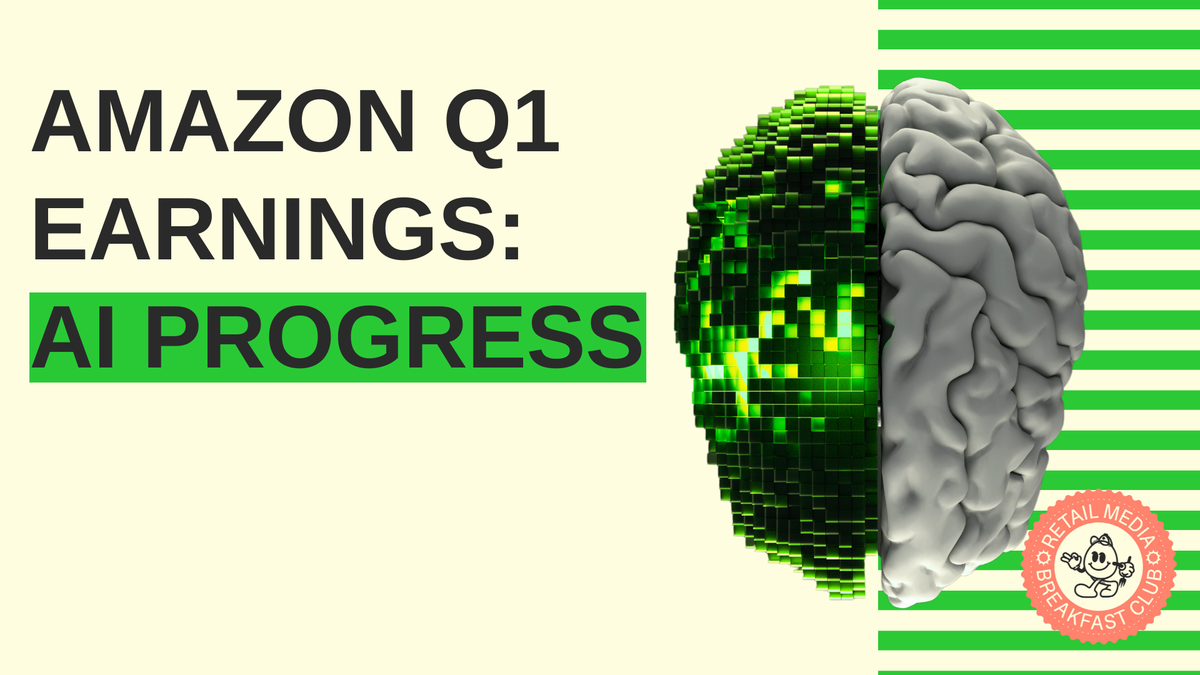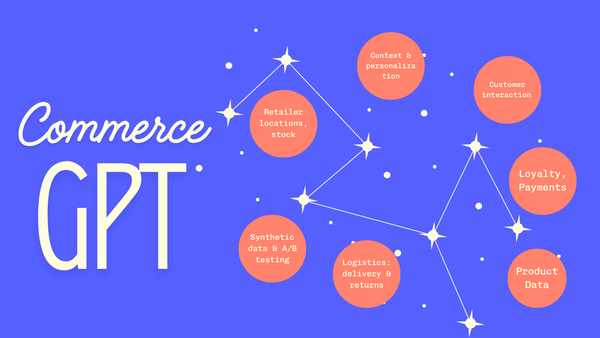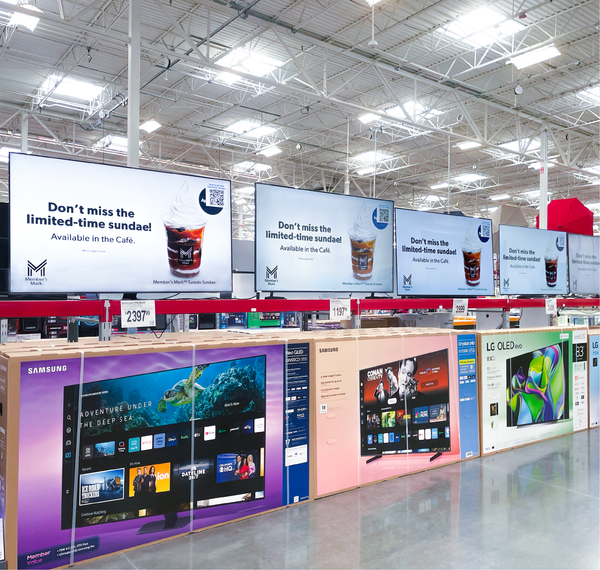"We're Not Dabbling Here" Amazon Q1 Earnings Highlight AI Progress

"We're not dabbling here" said Amazon CEO Andy Jassy on the company's earnings call on Thursday. That's an understatement.
Jassy pointed to a 'thousand plus AI applications' that are being baked at Amazon right now. As he put it: "If you believe your mission is to make customers' lives easier and better every day, and you believe that every customer experience will be reinvented with AI, you're gonna invest very aggressively in AI, and that's what we're doing."
I'm going break down all the AI news in the earnings call and couch it in terms of what it means for the actual consumer shopping journey, ecomm, and retail media. I'll tie it back as much as possible to practical takeaways. Let's jump in.
Major Model Announcements
1 - Nova Moves to "Frontier Tier"
Amazon's homegrown Nova model has now been upgraded to compete with top-tier models like Claude 3 and Llama 4. Jassy described it as delivering "frontier intelligence with industry-leading price performance." For retailers and advertisers, this means Amazon can power sophisticated shopping experiences - from detailed product descriptions to personalized recommendations - without relying on external AI providers.
Quick aside, what is 'frontier intelligence'? Until now Nova was Amazon’s workhorse model optimized for cost-per-token. By labelling the latest version “frontier intelligence,” Jassy is signaling that Nova now competes with GPT-4-level and Claude 3-level models on reasoning depth and context window, not just price. Translation for commerce: Amazon can keep progress inside its own house while still powering higher-order tasks such as multi-language product summaries, bundle building and agentic shopping conversations—all without renting OpenAI or Anthropic.
2 - NovaSonic: Voice Shopping Gets Serious
The new NovaSonic speech-to-speech foundation model addresses key barriers that prevented voice shopping from taking off previously:
- Lower word error rates (understands customers the first time)
- More natural-sounding responses
- Ability to maintain conversation context
Previous voice shopping failed largely due to transcription errors, robotic-sounding responses, and lack of "conversation memory." NovaSonic tackles these issues head-on: it understands requests the first time and responds with human-like speech patterns while maintaining context across multiple exchanges. This fluency is critical for consumers to trust an AI with purchasing decisions—especially in screen-free environments like kitchens or cars.
While many companies are developing text-based chatbots, Amazon's investment in NovaSonic shows a distinctive emphasis on voice commerce—leveraging their existing Alexa footprint in millions of homes, something competitors can't match.
Competitive positioning: While many companies are developing chatbots and text interfaces, Amazon's investment in NovaSonic shows a distinctive emphasis on voice commerce - leveraging their existing Alexa footprint in millions of homes, something competitors can't match.
What this means:
- Voice and multimodal search will likely become primary shopping entry points. Expect product searches like: "Alexa, show me a cruelty-free mascara under $25 that can ship by Friday." The agent handles filtering, inventory checks, and payment processing. For advertisers, sponsored placements will need to fit naturally within conversational answers rather than appearing on traditional search result grids.
- We'll see speech in Alexa+ but possibly also other Amazon apps - to get everyone used to voice interactions, Amazon could introduce voice interfaces in Amazon’s mobile app search bar (just like we're starting to talk to ChatGPT now) and Fire TV voice remote.
Agents and Applications
1 - Alexa Plus: A Subscription Shopping Assistant
Amazon's next-generation assistant goes beyond just answering questions, it can take actions - making it a potential shopping concierge that could:
- Compare products and make recommendations
- Add items to cart
- Apply coupons
- Arrange returns
This is currently rolling out in the US, with global expansion planned later this year. Jassy says "People are really liking Alexa Plus this far."
What this means: Subscription agents could disrupt product discovery for repeat purchases. Alexa Plus already controls smart home devices and makes reservations; the next logical step is automating routine purchases with instructions like "keep my household stocked with the cheapest gluten-free cereal, switch brands if unit price rises 10%." This collapses top-funnel discovery, creating a new battlefield where brands compete to become the agent's default recommendation—a new kind of "invisible shelf."
Read more: Amazon's Patent Reveals How Alexa+ Will Transform Product Discovery
NovaACT: The Browser Agent (Research Preview)
While still in research stages, this browser-action agent aims to dramatically improve accuracy on multi-step tasks from today's 30-60% to over 90%. For e-commerce, this could eventually enable agents that autonomously:
- Navigate checkout flows
- Apply loyalty points
- Find the best deals across multiple retailers
- Surface sponsored offers throughout the journey
What this means: When NovaACT matures, an Amazon agent could comparison-shop across Nike.com, Walmart.com, and Amazon itself, then execute the best deal automatically. Amazon might embed this capability within Buy with Prime buttons or browser extensions, potentially capturing affiliate-style economics even for off-site purchases. This would require advertisers and retailers to rethink how they present offers to both human shoppers and AI agents simultaneously.
Read more: Amazon's 'Nova Act' & The Race to Control the Future of AI Shopping
Infrastructure & Business Impact Improvements
Cost Reduction: 30-40% Cheaper AI
Amazon highlighted significant cost reductions for AI inference thanks to their Trainium 2 chips. For retailers and advertisers, this makes AI features more economically viable in several ways:
- Personalization at scale: Lower costs enable retailers to generate unique product descriptions, recommendations, and visuals for individual customers without prohibitive expenses.
- Real-time creative optimization: Advertisers can afford to generate and test multiple creative variations per impression, potentially adjusting messaging based on individual shopping history.
- Embedded AI everywhere: As costs drop, AI features can be incorporated into lower-margin products and everyday shopping experiences that couldn't previously justify the expense.
Unlike competitors, Amazon is building across the entire AI stack from custom silicon to consumer experiences, giving them potential cost and integration advantages over companies focused on just one layer.
How This Reshapes Commerce
Amazon's Q1 AI announcements reveal a comprehensive strategy that spans from silicon to shopping experiences. By building frontier-class models, voice-first interfaces, and action-oriented agents, Amazon isn't just enhancing its current business—it's reshaping how people will discover, evaluate, and purchase products in the future.
For retailers and advertisers, the message is clear: prepare for a world where conversational interfaces replace traditional search boxes, where shopping agents make routine purchases automatically, and where dynamic, personalized content becomes the norm. Those who adapt their strategies to this AI-driven commerce landscape will thrive; those who don't may find themselves increasingly invisible to tomorrow's shoppers.





